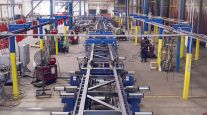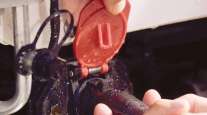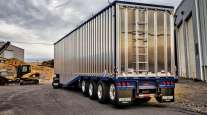New Materials and Techniques Save Weight, Fight Corrosion
By Eric Brothers, Special to Transport Topics
This story appears in the Nov. 1 print edition of Transport Topics.
New building techniques and innovative materials are helping to make trailers, especially dry vans and reefers, lighter, more fuel efficient and better at fighting corrosion, manufacturers said.
These benefits, especially technology that improves fuel efficiency, are allowing trailer makers to manufacture products that are not only more productive but are also environmentally friendly. Trailer skirts and tails are examples of this relatively new technology.
For example, Lafayette, Ind.-based Wabash National’s Dura-Plate AeroSkirt has been approved by the Environmental Protection Agency’s SmartWay program. The skirt produces a 6% fuel-efficiency improvement, said Tom Rodak, the company’s director of marketing.
EPA’s SmartWay Transport Partnership — the collaboration between the freight industry and the government designed to reduce greenhouse gas emissions and improve fuel efficiency — has developed a list of technologies and strategies to help reduce fuel consumption and improve efficiency and profitability. The use of trailer skirts and tails is among those strategies.
Rodak also said that its side skirts’ three-section 2.5-mm composite panels are 100% recyclable and can be installed on existing equipment or factory-installed on new trailers.
The industry’s first side skirts were not very flexible, but Utility Trailer, City of Industry, Calif., now offers two designs — the USS-120 and USS-160 — created with galvanized high-tensile steel braces that can bend back to their original shape if damaged.
Both designs are available as factory-installed options for new trailers or retrofitted for existing trailers available through Utility’s aftermarket department.
SmartWay has classified the Utility’s USS-160 as an “advanced side skirt” for dry vans, the company said.
Wabash National’s side skirts also are flexible.
For Utility’s customers, the skirts help fleets achieve “a minimum 5% fuel savings,” which means trailers equipped with them “do not need to be fitted with any other aerodynamic devices, such as gap fairings, to be SmartWay-verified or [California Air Resources Board] compliant,” said Chuck Cole, Utility’s manager of technical sales and product training.
“This can provide significant cost savings, especially for those looking to retrofit an existing trailer or fleet,” he said in a press release.
Savannah, Ga.-based Great Dane Trailers’ CTL trailer is available with Transtex Composite’s Maximum Flex Skirt, which the company said helps to increase fuel economy up to 7% on the highway.
And Hyundai Translead, San Diego, has partnered with Ridge Corp. to offer the latter’s Green Wing thermoplastic composite side fairings as the preferred aerodynamic component on all HT trailers.
The side fairing, made with recyclable materials, is UV protected, weighs less than 200 pounds, is dentproof and warranted against corrosion, according to Hyundai Translead.
Wabash National’s Rodak told Transport Topics that trailer skirts cost between $800 and $1,600 per truck.
Trailer tails also are designed to meet SmartWay specifications.
Aerodynamic Trailer Systems, Chagrin Falls, Ohio, recently introduced its SmartTail and WindTamer combination. According to the company, the two products combine to produce a 5.3% improvement in fuel efficiency, and both are SmartWay-certified.
SmartTail uses automated polymer skins mounted on the rear doors that inflate and deflate on their own when the vehicle reaches speeds of about 25 mph, said James Domo, CEO of ATS.
“No driver interaction is required” to inflate or deflate the SmartTail, he said, adding that this function is particularly useful when backing up to loading docks.
“For intermodal applications, the WindTamer allows machinery to pick up the trailer without having to worry about damaging the vehicle or its components, as could happen with side skirts,” Domo said, adding that the cost of the combined SmartTail and WindTamer package is about $2,500.
Refrigerated trailers also are getting greener. Making trailers more environmentally friendly begins with materials produced from recycled — and recyclable — content, such as the steel and plastics used in composite panels. The process continues with production methods that reduce greenhouse gas emissions and produce less harmful byproducts and less waste.
The finished product is designed to last longer, do more with less weight and travel the highways with less effort —which means less fuel used, leading to reduced emissions that further reduce the trailer’s environmental effects.
In its refrigerated trailers, Great Dane uses ThermoGuard, a glass-reinforced thermoplastic interior liner. The material incorporates a metalized film that minimizes outgassing through the liner, which allows the insulation to perform effectively longer.
By helping to maintain insulation performance, the liner can improve cooling unit performance, said Christopher Hammond IV, the company’s vice president of dealer sales.
“Our study shows that, after five years, the refrigeration unit will run more than 1,000 hours less and use 1,300 gallons less fuel, conservatively, so the additional cost pays off in two-and-a-half to three years,” he said.
One of the features that trailer-maker Hyundai Translead promotes is its corrosion-protection system, which uses hot-dipped galvanizing on its products’ steel components. The process involves immersing those components in a tank of molten zinc.
Christian Lee, vice president of research and development, said, “We feel that hot-dipped galvanized product will last 10 years plus, whereas a conventional paint system needs maintenance every few years.”
In addition, he said of the corrosion protection system: “We feel it is a little more environmentally friendly than a conventional polyurethane coating because it emits less greenhouse gas in application, compared to spray painting.”
Utility engineered its 4000D-X Composite dry van to provide improved sidewall durability and strength. It typically reduces the tare weight by 400 to 500 pounds when compared with most composite-plate trailers, Cole said.
Adding aerodynamic side skirts can increase the fuel-efficiency even more.
Saving weight is less important for loads that cube out long before they reach weight limits.
“The fractional percent of savings that can be achieved by weight can’t compare with the 5% to 6% average improvement from side skirts,” Cole said.
Everything else depends on the customers, he said: “We need to look at all aspects of their operation to figure out the lowest total cost of ownership.”
Wabash National offers a range of refrigerated and dry vans, including its DuraPlate brand composite sidewall trailer.
DuraPlate, constructed of a high-density polyethylene plastic core bonded between two high-strength steel skins, offers durability and impact resistance, and its materials are recyclable.
The composite sidewall panels help to maximize cube capacity and extend equipment life.
On the company’s FreightPro dry vans, a heavy-duty plastic interior liner offers greater protection against punctures and impact damage, compared with plywood.
Wabash National’s ArcticLite refrigerated vans use computer-controlled, high-pressure foam injection to eliminate voids in sidewalls for maximum thermal efficiency.




